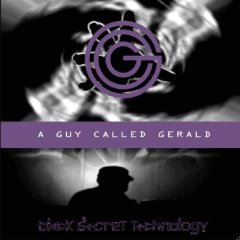Ironically for an album that takes its title from government surveillance techniques, A Guy Called Gerald’s masterpiece has remained almost untraceable for over a decade. While Goldie’s gleaming Timeless has continued to be held up as jungle’s finest hour, Black Secret Technology — despite love from the scene and critics on its 1995 release — has kicked around in two different, difficult-to-find CD versions, both masked by mastering so dishwatery it managed to take the “bass” out of “drum and bass”. But without fanfare, Gerald has finally made it available in its full, punchy, pressure-drop glory.
Black Secret Technology is not just the best album to come out of that scene: it’s one of the best dance albums ever made. Everything vital about the beat science space race of the early/mid-90s is present in its DNA. Like Wu Tang, Tricky and Carl Craig, Gerald had a strong, underground form to fuck with from a step’s remove, seemingly drawing on sense memories of reggae, soul and jazz as he did so. Surfacing simultaneously with new, gnostic knowledge from retreats in rainy cities, they all squeezed the inexplicable shapes of subjective experience through fairly basic machinery. But, having jungle to work with, Gerald was always going to get ahead.
UK rave pursued berserk new sensations as a matter of course, but jungle’s raw, impossibly accelerated breakbeats (and ruffneck clientele) were scorned and feared by many at first. Black Secret Technology captures the tipping point at which hardcore rhythms sped up so much that they bent time, found the half-beat, a human heartbeat in the modern maelstrom. Refinement can be a hard sell as a vanguard approach, but precision chaos was Gerald’s signature style: he caught jungle’s runaway power with an economy more often associated with Detroit techno.
Though painstakingly arranged, the album doesn’t once sound fussy or fastidious. It bursts with life: polyrhythms clatter without clutter, shaking your bones with devastating symmetry; vivid, shape-shifting electronics connect more intimately than organic sounds could; disembodied voices resonate, still snaking through your psyche long after you’ve stopped listening. The hit you get is one of impossible intensification: too much as a more accurate, heightened representation of real-life experience. (Somehow, ‘Finlay’s Rainbow’ and ‘The Nile’ both manage to sound at once elated, vulnerable and invincible.)
If there’s a concept, it’s a productively open-ended one. In the sleevenotes, Gerald points to ancient African tribal cultures: “rhythm helped early man to get in touch with the universe and his small part in it . . . I believe that these trance-like rhythms reflect my frustration to know the truth about my ancestors who talked with drums.” These ideas of orientation and discovery through rhythm lend Black Secret Technology a loose narrative. After segueing from warm welcoming tracks into spellbinding confusion in the first half, it presents the ecstasy of breakthrough — the back-masked and stretched snares of ‘Dreaming of You’ and ‘Survival’ sound as if they’re communicating new ways to connect, to yourself and to others. It builds to thunderous celebration in the rave-iest tracks, ‘Cybergen’ and ‘The Reno’, and finally transforms past glories — ‘Gloc’ into ‘Cyberjazz’ and Gerald’s biggest hit, ‘Voodoo Ray’, into the display of new mastery, ‘Voodoo Rage’ — before returning to benevolent source on the closing ‘Life Unfolds His Mystery’.
The paranoia and urban darkness some people identified in Black Secret Technology when it first came out are less apparent now, perhaps because those aspects have been taken further by grime and dubstep. What stands is psychedelic rhythm with a purpose: to reconnect in the midst of a formless and hectic present, to present a human glow in the midst of a harsh environment. It stands as a victory of form over circumstance that’s yet to be outstripped.


